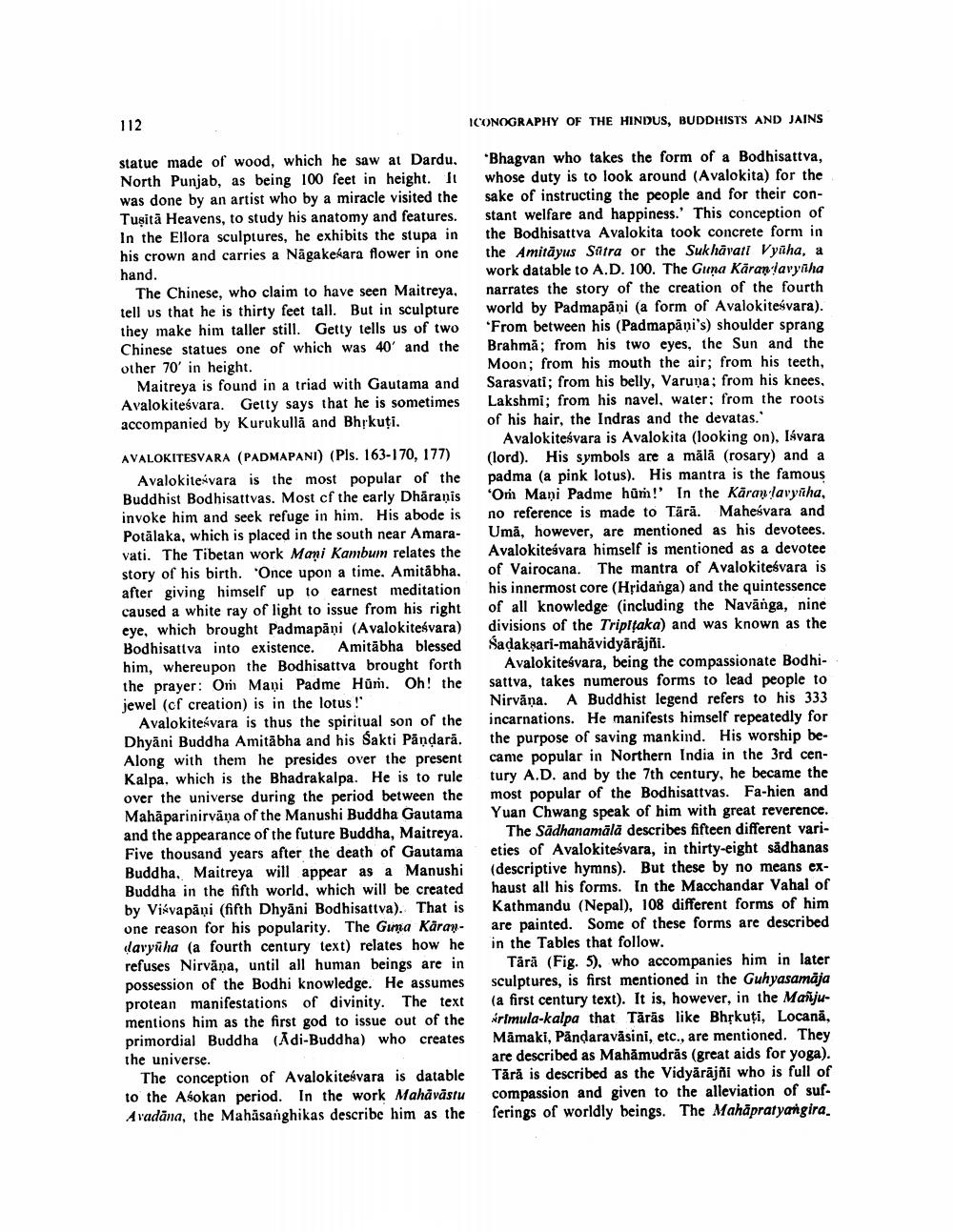________________
112
ICONOGRAPHY OF THE HINDUS, BUDDHISTS AND JAINS
statue made of wood, which he saw at Dardu. North Punjab, as being 100 feet in height. It was done by an artist who by a miracle visited the Tuşită Heavens, to study his anatomy and features. In the Ellora sculptures, he exhibits the stupa in his crown and carries a Nägakekara flower in one hand.
The Chinese, who claim to have seen Maitreya, tell us that he is thirty feet tall. But in sculpture they make him taller still. Getty tells us of two Chinese statues one of which was 40' and the other 70' in height.
Maitreya is found in a triad with Gautama and Avalokitesvara. Getty says that he is sometimes accompanied by Kurukullā and Bhrkuti. AVALOKITESVARA (PADMAPANI) (Pls. 163-170, 177)
Avalokitesvara is the most popular of the Buddhist Bodhisattvas. Most of the early Dharanis invoke him and seek refuge in him. His abode is Potälaka, which is placed in the south near Amaravati. The Tibetan work Mani Kambum relates the story of his birth. "Once upon a time. Amitabha. after giving himself up to earnest meditation caused a white ray of light to issue from his right eye, which brought Padmapāņi (Avalokitesvara) Bodhisattva into existence. Amitabha blessed him, whereupon the Bodhisattva brought forth the prayer: Om Mani Padme Hüm. Oh! the jewel (of creation) is in the lotus!"
Avalokitesvara is thus the spiritual son of the Dhyāni Buddha Amitabha and his Sakti Pāndara. Along with them he presides over the present Kalpa, which is the Bhadrakalpa. He is to rule over the universe during the period between the Mahāparinirvana of the Manushi Buddha Gautama and the appearance of the future Buddha, Maitreya. Five thousand years after the death of Gautama Buddha, Maitreya will appear as a Manushi Buddha in the fifth world, which will be created by Visvapāņi (fifth Dhyāni Bodhisattva). That is one reason for his popularity. The Guņa Kāra»- daryaha (a fourth century text) relates how he refuses Nirvāna, until all human beings are in possession of the Bodhi knowledge. He assumes protean manifestations of divinity. The text mentions him as the first god to issue out of the primordial Buddha (Adi-Buddha) who creates the universe.
The conception of Avalokitesvara is datable to the Asokan period. In the work Mahāvāstu Avadāna, the Mahasanghikas describe him as the
"Bhagvan who takes the form of a Bodhisattva, whose duty is to look around (Avalokita) for the sake of instructing the people and for their constant welfare and happiness.' This conception of the Bodhisattva Avalokita took concrete form in the Amitäyus Satra or the Sukhävall Vyaha, a work datable to A.D. 100. The Guna Karan larynha narrates the story of the creation of the fourth world by Padmapāni (a form of Avalokitesvara). 'From between his (Padmapāņi's) shoulder sprang Brahmå; from his two eyes, the Sun and the Moon; from his mouth the air; from his teeth, Sarasvati; from his belly, Varuņa; from his knees, Lakshmi; from his navel, water; from the roots of his hair, the Indras and the devatas.'
Avalokitesvara is Avalokita (looking on), Isvara (lord). His symbols are a mälä (rosary) and a padma (a pink lotus). His mantra is the famous 'Om Mani Padme hum!' In the Kāran lavyliha, no reference is made to Tārā. Maheśvara and Umä, however, are mentioned as his devotees. Avalokitesvara himself is mentioned as a devotee of Vairocana. The mantra of Avalokitesvara is his innermost core (Hșidanga) and the quintessence of all knowledge (including the Navānga, nine divisions of the Tripitaka) and was known as the Sadakşari-mahăvidyārājñi.
Avalokitesvara, being the compassionate Bodhisattva, takes numerous forms to lead people to Nirvāna. A Buddhist legend refers to his 333 incarnations. He manifests himself repeatedly for the purpose of saving mankind. His worship became popular in Northern India in the 3rd century A.D. and by the 7th century, he became the most popular of the Bodhisattvas. Fa-hien and Yuan Chwang speak of him with great reverence.
The Sadhanamäla describes fifteen different varieties of Avalokitesvara, in thirty-eight sådhanas (descriptive hymns). But these by no means exhaust all his forms. In the Macchandar Vahal of Kathmandu (Nepal), 108 different forms of him are painted. Some of these forms are described in the Tables that follow.
Tåră (Fig. 5), who accompanies him in later sculptures, is first mentioned in the Guhyasamaja (a first century text). It is, however, in the ManjuArlmula-kalpa that Tārās like Bhrkuti, Locană, Måmaki, Pändaraväsini, etc., are mentioned. They are described as Mahmudrās (great aids for yoga). Tără is described as the Vidyārājñi who is full of compassion and given to the alleviation of sufferings of worldly beings. The Mahāpratyangira.




